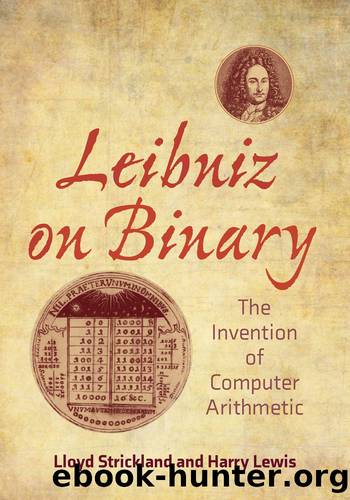Leibniz on Binary by Lloyd Strickland

Author:Lloyd Strickland
Language: eng
Format: epub
Tags: Leibniz; Binary; Hexadecimal; Sedecimal; Computing; Digital
Publisher: MIT Press
So the last digit of the ternary number is a, that is to say the same as the last digit of the natural number, namely 01, or indeed 010101 etc.
The penultimate digit has to be made from a and b, or a + b, that is from 0101 + 0011 = 0110, where the dot above the last 0 in the calculation in the margin10 signifies that a 1 should be saved for the next or antepenultimate column c + b in the fourth place of its period. Consequently there will be in this column 0011 0011 + 0000 1111 + 0001 0001, which gives 0010 1101, the dots above the digits in the margin marking again that which needs to be saved. In the same way it will be found following the calculation in the margin that the preantepenultimate column, where there is d + c, will give as period 0001 1100 1110 0011.
I wish I could already give the general rule to infinity of these periods for each column, and I have no doubt it will be found, but these things donât happen all of a sudden. In any case, it seems to me that I have already mentioned a beautiful theorem, that one half of the period is always the complement of the other, where when I say complement, I mean that where one has 0 the other has 1 or vice versa. For example, 0110 has two halves , and 0010 1101 has two halves , and finally 0001 1100 1110 0011 also has two halves .
A thousand pardons, Sir, for a letter written in such confusion. Wishing you a good century and good year with all kinds of satisfaction, I am sincerely, Sir,
Your very humble and very obedient servant,
Leibniz.11
Download
This site does not store any files on its server. We only index and link to content provided by other sites. Please contact the content providers to delete copyright contents if any and email us, we'll remove relevant links or contents immediately.
4 3 2 1: A Novel by Paul Auster(11823)
The handmaid's tale by Margaret Atwood(7471)
Giovanni's Room by James Baldwin(6830)
Asking the Right Questions: A Guide to Critical Thinking by M. Neil Browne & Stuart M. Keeley(5371)
Big Magic: Creative Living Beyond Fear by Elizabeth Gilbert(5364)
Ego Is the Enemy by Ryan Holiday(4972)
On Writing A Memoir of the Craft by Stephen King(4677)
The Body: A Guide for Occupants by Bill Bryson(4603)
Ken Follett - World without end by Ken Follett(4453)
Bluets by Maggie Nelson(4284)
Adulting by Kelly Williams Brown(4246)
Eat That Frog! by Brian Tracy(4171)
Guilty Pleasures by Laurell K Hamilton(4128)
White Noise - A Novel by Don DeLillo(3838)
The Poetry of Pablo Neruda by Pablo Neruda(3828)
Fingerprints of the Gods by Graham Hancock(3749)
Alive: The Story of the Andes Survivors by Piers Paul Read(3743)
The Book of Joy by Dalai Lama(3714)
The Bookshop by Penelope Fitzgerald(3629)
